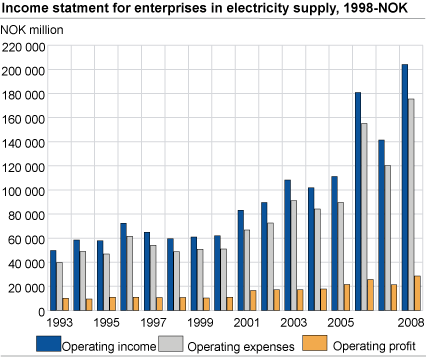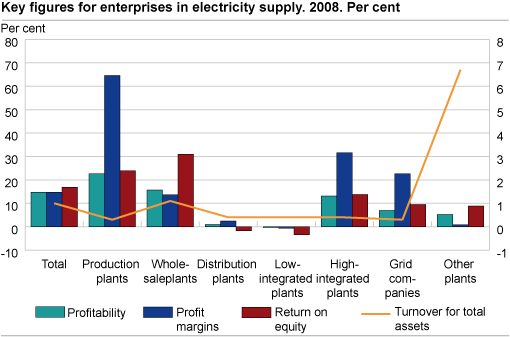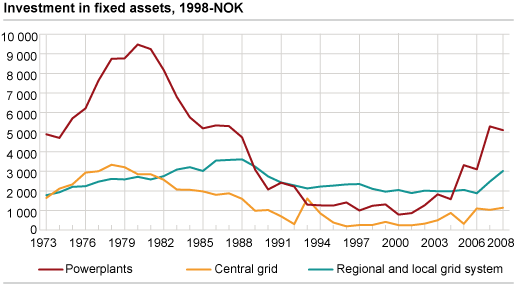Content
Published:
This is an archived release.
All time high operating profit
The operating profit came to NOK 35.1 billion in 2008. This is an increase of 39 per cent compared with 2007, and the highest figure ever recorded in current prices in the annual electricity statistics.
The all time high operating profit can be viewed in conjunction with very high electricity generation and high electricity prices. The production plants had the highest operating profit in 2008. This is also the case for previous years. The operating profit of production plants amounted to NOK 26.9 billion. The wholesale plants achieved an operating profit of NOK 1.1 billion, while the operating profit of grid companies and remaining plants totalled NOK 3.2 and NOK 3.9 billion respectively.
Strong increase in value added
Production value and value added in the power industry came to NOK 64.2 and NOK 49.5 billion respectively in 2008; an increase of 23 and 25 per cent compared with 2007. This must be viewed in conjunction with high electricity generation and high electricity prices.
All time high gross investments
The gross investments (purchase minus sale) in the power industry totalled NOK 12.9 billion in 2008. This is 16 per cent more than in 2007 and the highest figure ever recorded in current prices in the statistics. Gross investments in water power plants, hydro-electric power stations, thermal power plants and wind power plants were NOK 405, 3292, 1 892 and 605 million respectively.
Higher consumption of electricity
There was an increase of 1.4 per cent in electricity consumption from 2007 to 2008 and total net consumption totalled 116.6 TWh. While the electricity consumption in households and construction other services fell by 0.2 and 0.4 TWh, the electricity consumption in power intensive manufacturing rose by 1.3 TWh.
The electricity consumption in cottages and holiday houses came to 1.5 TWh; an increase of 8.2 per cent compared with 2007. Although the electricity consumption in cottages and holiday houses has increased roughly by 6-8 per cent in each year since 2004, it only amounted to 1.3 per cent of the total net consumption in 2008. The electricity consumption in cottages and holiday houses was approximately 1 TWh in 2000.
Electricity generation at record level
The electricity generation totalled 142.1 TWh in 2008; an increase of 3.6 per cent compared with 2007 and only 0.7 TWh below the record from 2000. The high electricity generation can be viewed in conjunction with high inflow of water to the reservoirs and filling above the median until September, in addition to high electricity prices. Norway’s exports of power came to 17.3 TWh in 2008, while imports totalled 3.4 TWh. This gave a net export of 13.9 TWh; the second highest figure ever recorded in the 2000s.
Electricity prices
The total electricity bill of households consists of power price, grid rent and public taxes (consumer tax and VAT). The total price of households rose from 63.2 øre/kWh in 2007 to 74.9 øre/kWh in 2008, excluding VAT. Power price, grid rent and consumer tax were 39.9, 24.8, 10.2 øre/kWh respectively.
Important announcement:In the electricity statistics of 2008 the power sale and distribution of electricity to different end users are based on a new version of Norwegian industry classification (SIC2007) . The numbers of end users increase from 27 to 36 categories in the statistics of 2008 with more categories in services. The change results in some problems in comparing the 2008-statistics with previous annual electricity statistics. |
Tables:
- Table 1 Main figures. 1989-2008
- Table 2 Capacity of installed machinery, by type, county and ownership group. 2008
- Table 3 Power stations, by size (maximum output). 1974-2008
- Table 4 Hydro-electric power stations, by size (maximum output) and county/ownership group. 2008
- Table 5 Lines at the end of the year, by type of line and voltage. 2008. Km
- Table 6 Lines at the end of the year, by type of line and county1
- Table 7 Transformers at the end of the year, by county/ownership group. 2008
- Table 8 Production, imports, exports and consumption of electric energy. 1950, 1955 and 1960-2008. GWh
- Table 9 Production of electric energy, by type, county and ownership group. 2006-2008. GWh
- Table 10 Net consumption of electric energy, by type and consumer group. 2007 and 2008. GWh
- Table 11 Net consumption of total electric energy, priority and non-priority, by consumer group and county. 2007 and 2008. GWh
- Table 12 Net consumption of total electric energy in households per capita, by county. 1994-2008. kWh
- Table 13 Prices on electricity and grid rent excluding taxes, by consumer group. 2008. øre/kWh
- Table 14 Prices on electricity and grid rent to households, by county. 2008. øre/kWh
- Table 15 Prices of electric energy traded in the wholesale market and concession power. 1994-2008. øre/kWh
- Table 16 Number of utilities and generators, persons engaged and staff-years, by type of utility and activity. 2007 and 2008
- Table 17 Economic main figures for all units in electricity supply. 2000 and 2008. NOK million
- Table 18 Income statment for enterprises in electricity supply, by type of utility. 2007 og 2008. NOK million
- Table 19 Balance sheet for enterprises in electricity supply, by type of utility. 2007 and 2008. NOK million
- Table 20 Key figures for enterprises in electricity supply, by type of utility. 2007 and 2008.
- Table 21 Income statment for enterprises in electricity supply, by ownership group. NOK million
- Table 22 Balance sheet for enterprises in electricity supply, by ownership group. 2007 and 2008. NOK million
- Table 23 Key figures for enterprises in electricity supply, by type of utility
- Table 24 Acquisition and sale of fixed assets, by type of capital. 2008. NOK million
- Table 25 Acquisition of fixed assets, by type of utility, county and ownership group. 2008. NOK million
The statistics is published with Electricity.
Contact
-
Statistics Norway's Information Centre
E-mail: informasjon@ssb.no
tel.: (+47) 21 09 46 42



